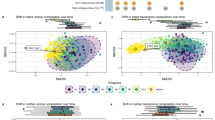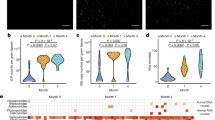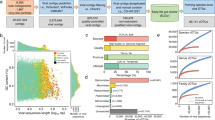Abstract
The early years of life are important for immune development and influence health in adulthood. Although it has been established that the gut bacterial microbiome is rapidly acquired after birth, less is known about the viral microbiome (or 'virome'), consisting of bacteriophages and eukaryotic RNA and DNA viruses, during the first years of life. Here, we characterized the gut virome and bacterial microbiome in a longitudinal cohort of healthy infant twins. The virome and bacterial microbiome were more similar between co-twins than between unrelated infants. From birth to 2 years of age, the eukaryotic virome and the bacterial microbiome expanded, but this was accompanied by a contraction of and shift in the bacteriophage virome composition. The bacteriophage-bacteria relationship begins from birth with a high predator–low prey dynamic, consistent with the Lotka-Volterra prey model. Thus, in contrast to the stable microbiome observed in adults, the infant microbiome is highly dynamic and associated with early life changes in the composition of bacteria, viruses and bacteriophages with age.
This is a preview of subscription content, access via your institution
Access options
Subscribe to this journal
Receive 12 print issues and online access
$209.00 per year
only $17.42 per issue
Buy this article
- Purchase on Springer Link
- Instant access to full article PDF
Prices may be subject to local taxes which are calculated during checkout






Similar content being viewed by others
References
Virgin, H.W. The virome in mammalian physiology and disease. Cell 157, 142–150 (2014).
Norman, J.M., Handley, S.A. & Virgin, H.W. Kingdom-agnostic metagenomics and the importance of complete characterization of enteric microbial communities. Gastroenterology 146, 1459–1469 (2014).
Qin, N. et al. Alterations of the human gut microbiome in liver cirrhosis. Nature 513, 59–64 (2014).
Cho, I. & Blaser, M.J. The human microbiome: at the interface of health and disease. Nat. Rev. Genet. 13, 260–270 (2012).
Littman, D.R. & Pamer, E.G. Role of the commensal microbiota in normal and pathogenic host immune responses. Cell Host Microbe 10, 311–323 (2011).
Borody, T.J. & Khoruts, A. Fecal microbiota transplantation and emerging applications. Nat. Rev. Gastroenterol. Hepatol. 9, 88–96 (2012).
Gritz, E.C. & Bhandari, V. The human neonatal gut microbiome: a brief review. Front. Pediatr 3, 17 (2015).
Koenig, J.E. et al. Succession of microbial consortia in the developing infant gut microbiome. Proc. Natl. Acad. Sci. USA 108 (suppl. 1), 4578–4585 (2011).
Yatsunenko, T. et al. Human gut microbiome viewed across age and geography. Nature 486, 222–227 (2012).
Subramanian, S. et al. Persistent gut microbiota immaturity in malnourished Bangladeshi children. Nature 510, 417–421 (2014).
Bäckhed, F. et al. Dynamics and stabilization of the human gut microbiome during the first year of life. Cell Host Microbe 17, 690–703 (2015).
Dominguez-Bello, M.G. et al. Delivery mode shapes the acquisition and structure of the initial microbiota across multiple body habitats in newborns. Proc. Natl. Acad. Sci. USA 107, 11971–11975 (2010).
La Rosa, P.S. et al. Patterned progression of bacterial populations in the premature infant gut. Proc. Natl. Acad. Sci. USA 111, 12522–12527 (2014).
Turnbaugh, P.J. et al. A core gut microbiome in obese and lean twins. Nature 457, 480–484 (2009).
Walter, J. & Ley, R. The human gut microbiome: ecology and recent evolutionary changes. Annu. Rev. Microbiol. 65, 411–429 (2011).
Palmer, C., Bik, E.M., DiGiulio, D.B., Relman, D.A. & Brown, P.O. Development of the human infant intestinal microbiota. PLoS Biol. 5, e177 (2007).
Reyes, A. et al. Viruses in the faecal microbiota of monozygotic twins and their mothers. Nature 466, 334–338 (2010).
Goodrich, J.K. et al. Human genetics shape the gut microbiome. Cell 159, 789–799 (2014).
Oh, J. et al. Biogeography and individuality shape function in the human skin metagenome. Nature 514, 59–64 (2014).
De Vlaminck, I. et al. Temporal response of the human virome to immunosuppression and antiviral therapy. Cell 155, 1178–1187 (2013).
Béland, K. et al. Torque Teno virus in children who underwent orthotopic liver transplantation: new insights about a common pathogen. J. Infect. Dis. 209, 247–254 (2014).
McElvania TeKippe, E. et al. Increased prevalence of anellovirus in pediatric patients with fever. PLoS ONE 7, e50937 (2012).
Li, L. et al. AIDS alters the commensal plasma virome. J. Virol. 87, 10912–10915 (2013).
Handley, S.A. et al. Pathogenic simian immunodeficiency virus infection is associated with expansion of the enteric virome. Cell 151, 253–266 (2012).
Barton, E.S. et al. Herpesvirus latency confers symbiotic protection from bacterial infection. Nature 447, 326–329 (2007).
Minot, S. et al. Rapid evolution of the human gut virome. Proc. Natl. Acad. Sci. USA 110, 12450–12455 (2013).
Breitbart, M. et al. Metagenomic analyses of an uncultured viral community from human feces. J. Bacteriol. 185, 6220–6223 (2003).
Minot, S. et al. The human gut virome: inter-individual variation and dynamic response to diet. Genome Res. 21, 1616–1625 (2011).
Norman, J.M. et al. Disease-specific alterations in the enteric virome in inflammatory bowel disease. Cell 160, 447–460 (2015).
Parsons, R.J., Breitbart, M., Lomas, M.W. & Carlson, C.A. Ocean time-series reveals recurring seasonal patterns of virioplankton dynamics in the northwestern Sargasso Sea. ISME J. 6, 273–284 (2012).
Hennes, K.P. & Simon, M. Significance of bacteriophages for controlling bacterioplankton growth in a mesotrophic lake. Appl. Environ. Microbiol. 61, 333–340 (1995).
Cortez, M.H. & Weitz, J.S. Coevolution can reverse predator-prey cycles. Proc. Natl. Acad. Sci. USA 111, 7486–7491 (2014).
Breitbart, M. et al. Viral diversity and dynamics in an infant gut. Res. Microbiol. 159, 367–373 (2008).
Kapusinszky, B., Minor, P. & Delwart, E. Nearly constant shedding of diverse enteric viruses by two healthy infants. J. Clin. Microbiol. 50, 3427–3434 (2012).
Finkbeiner, S.R. et al. Metagenomic analysis of human diarrhea: viral detection and discovery. PLoS Pathog. 4, e1000011 (2008).
Holtz, L.R. et al. Geographic variation in the eukaryotic virome of human diarrhea. Virology 468–470, 556–564 (2014).
Kapoor, A. et al. A highly prevalent and genetically diversified Picornaviridae genus in South Asian children. Proc. Natl. Acad. Sci. USA 105, 20482–20487 (2008).
Olszak, T. et al. Microbial exposure during early life has persistent effects on natural killer T cell function. Science 336, 489–493 (2012).
Gurnee, E.A. et al. Gut colonization of healthy children and their mothers with pathogenic ciprofloxacin-resistant Escherichia coli. J. Infect. Dis. doi:10.1093/infdis/jiv279 (2015).
Edwards, R.A. & Rohwer, F. Viral metagenomics. Nat. Rev. Microbiol. 3, 504–510 (2005).
Dutilh, B.E. et al. A highly abundant bacteriophage discovered in the unknown sequences of human faecal metagenomes. Nat. Commun. 5, 4498 (2014).
Ninomiya, M., Takahashi, M., Nishizawa, T., Shimosegawa, T. & Okamoto, H. Development of PCR assays with nested primers specific for differential detection of three human anelloviruses and early acquisition of dual or triple infection during infancy. J. Clin. Microbiol. 46, 507–514 (2008).
Rodriguez-Valera, F. et al. Explaining microbial population genomics through phage predation. Nat. Rev. Microbiol. 7, 828–836 (2009).
Thingstad, T.F. Elements of a theory for the mechanisms controlling abundance, diversity, and biogeochemical role of lytic bacterial viruses in aquatic systems. Limnol. Oceanogr. 45, 1320–1328 (2000).
Kircher, M., Heyn, P. & Kelso, J. Addressing challenges in the production and analysis of illumina sequencing data. BMC Genomics 12, 382 (2011).
Félix, M.A. et al. Natural and experimental infection of Caenorhabditis nematodes by novel viruses related to nodaviruses. PLoS Biol. 9, e1000586 (2011).
Aronesty, E. ea-utils: command-line tools for processing biological sequencing data http://code.google.com/p/ea-utils (2011).
Li, W. & Godzik, A. Cd-hit: a fast program for clustering and comparing large sets of protein or nucleotide sequences. Bioinformatics 22, 1658–1659 (2006).
Zhao, G. et al. Identification of novel viruses using VirusHunter—an automated data analysis pipeline. PLoS ONE 8, e78470 (2013).
Huson, D.H., Mitra, S., Ruscheweyh, H.J., Weber, N. & Schuster, S.C. Integrative analysis of environmental sequences using MEGAN4. Genome Res. 21, 1552–1560 (2011).
Oksanen, J.F et al. vegan: Community Ecology Package. R package version 2.0-10 https://cran.r-project.org/web/packages/vegan/index.html (2013).
Vázquez-Baeza, Y., Pirrung, M., Gonzalez, A. & Knight, R. EMPeror: a tool for visualizing high-throughput microbial community data. Gigascience 2, 16 (2013).
Langmead, B. & Salzberg, S.L. Fast gapped-read alignment with Bowtie 2. Nat. Methods 9, 357–359 (2012).
Kearse, M. et al. Geneious Basic: an integrated and extendable desktop software platform for the organization and analysis of sequence data. Bioinformatics 28, 1647–1649 (2012).
Guindon, S. & Gascuel, O. A simple, fast, and accurate algorithm to estimate large phylogenies by maximum likelihood. Syst. Biol. 52, 696–704 (2003).
Abascal, F., Zardoya, R. & Posada, D. ProtTest: selection of best-fit models of protein evolution. Bioinformatics 21, 2104–2105 (2005).
Darriba, D., Taboada, G.L., Doallo, R. & Posada, D. jModelTest 2: more models, new heuristics and parallel computing. Nat. Methods 9, 772 (2012).
Nix, W.A. et al. Detection of all known parechoviruses by real-time PCR. J. Clin. Microbiol. 46, 2519–2524 (2008).
Margulies, M. et al. Genome sequencing in microfabricated high-density picolitre reactors. Nature 437, 376–380 (2005).
Li, H. et al. The Sequence Alignment/Map format and SAMtools. Bioinformatics 25, 2078–2079 (2009).
Caporaso, J.G. et al. QIIME allows analysis of high-throughput community sequencing data. Nat. Methods 7, 335–336 (2010).
McDonald, D. et al. An improved Greengenes taxonomy with explicit ranks for ecological and evolutionary analyses of bacteria and archaea. ISME J. 6, 610–618 (2012).
Caporaso, J.G. et al. Global patterns of 16S rRNA diversity at a depth of millions of sequences per sample. Proc. Natl. Acad. Sci. USA 108 (suppl. 1), 4516–4522 (2011).
Acknowledgements
We thank the infants' families and physicians for their participation in, and cooperation with, the study. This work was supported in part by the Children's Discovery Institute (MD-FR-2013-292) and the US National Institutes of Health (5P30 DK052574 (Biobank, Digestive Diseases Research Core Centers) to P.I.T. and UH3AI083265 to P.I.T. and B.B.W.). P.I.T. and B.B.W. received funding from the Eunice Kennedy Shriver National Institute of Child Health and Human Development and from the Foundation for the National Institutes of Health (made possible by support from the Gerber Foundation). D.W. holds an Investigator in the Pathogenesis of Infectious Disease award from the Burroughs Wellcome Fund. E.S.L. is an Eli & Edythe Broad Fellow of the Life Sciences Research Foundation.
Author information
Authors and Affiliations
Contributions
E.S.L., L.R.H. and D.W. conceived and designed the experiments. L.D., I.K.B. and E.S.L. prepared samples for sequencing. E.S.L and I.K.B. performed PCR experiments. E.S.L., G.Z. and Y.Z. processed and analyzed the sequencing data. P.I.T., B.B.W. and I.M.N. recruited the study participants and managed the metadata. E.S.L., L.R.H., D.W. and P.I.T. wrote and edited the manuscript.
Corresponding authors
Ethics declarations
Competing interests
The authors declare no competing financial interests.
Supplementary information
Supplementary Text and Figures
Supplementary Figures 1–6 (PDF 3204 kb)
Rights and permissions
About this article
Cite this article
Lim, E., Zhou, Y., Zhao, G. et al. Early life dynamics of the human gut virome and bacterial microbiome in infants. Nat Med 21, 1228–1234 (2015). https://doi.org/10.1038/nm.3950
Received:
Accepted:
Published:
Issue Date:
DOI: https://doi.org/10.1038/nm.3950
This article is cited by
-
Eco-evolutionary dynamics of gut phageome in wild gibbons (Hoolock tianxing) with seasonal diet variations
Nature Communications (2024)
-
Exploring the Human Virome: Composition, Dynamics, and Implications for Health and Disease
Current Microbiology (2024)
-
The infant gut virome is associated with preschool asthma risk independently of bacteria
Nature Medicine (2024)
-
Gut commensal Enterocloster species host inoviruses that are secreted in vitro and in vivo
Microbiome (2023)
-
The identification and genetic characteristics of Quang Binh virus from field-captured Culex tritaeniorhynchus (Diptera: Culicidae) from Guizhou Province, China
Parasites & Vectors (2023)



